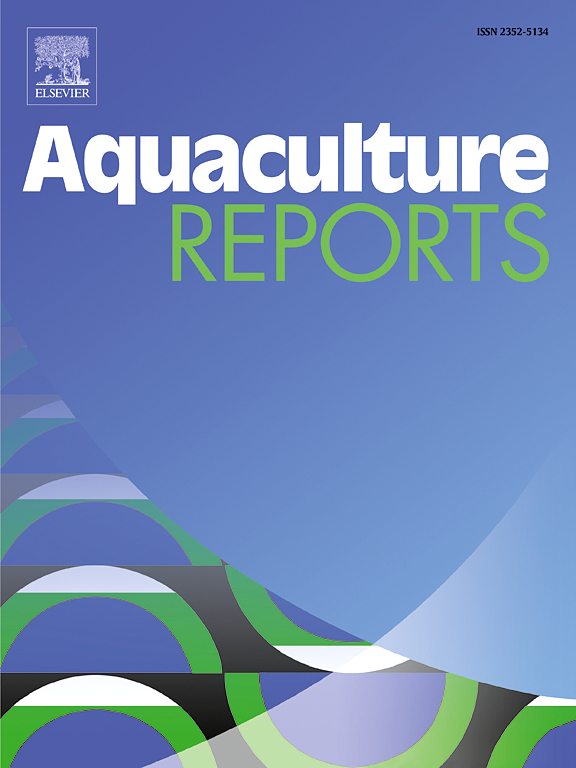Biological properties of Vibrio parahaemolyticus lytic phages and transcriptome analysis of their interactions with the host
IF 3.2
2区 农林科学
Q1 FISHERIES
引用次数: 0
Abstract
Vibrio parahaemolyticus (V. parahaemolyticus) is an opportunistic pathogen primarily affecting aquaculture animals, leading to severe aquatic animal diseases and fatalities. Furthermore, the consumption of undercooked seafood contaminated with this strain can lead to acute gastroenteritis in humans. Bacteriophages are considered as potential antibiotic alternatives that could effectively mitigate the harmful impacts of Vibrio. The complex relationship between phages and their hosts is still not fully understood. By exploring the fundamental biological characteristics of phages and the transcription of host mRNA during interactions with their hosts, we can systematically investigate the regulatory networks that govern the function of host molecules produced by both phages and bacteria. We isolated a lytic V. parahaemolyticus phage, vB-VpaS-SD15 (P15), from a shrimp culture pond. Transmission electron microscopy revealed that P15 is a member of the Siphoviridae family of tailed phages. The host spectrum of 138 V. parahaemolyticus strains isolated from aquaculture ponds in the southeastern coast of China was evaluated, indicating that this phage strain could lyse 33 V. parahaemolyticus strains efficiently within a a brief culture period. Furthermore, it exhibited prolonged stability at temperatures up to 60°C, a broad pH range from 2 to 12, diverse forms, and an infection multiplier of 0.01, and the burst volume is about 23 PFU/mL. We completed an interaction map of the host bacterial and phage gene frameworks. Host bacteria were collected at different time points (5 min, 20 min, 40 min, 60 min, 100 min) representing incubation, burst, and plateau phases of phage infection, and were depicted as one-step growth curves. RNA-seq technology was utilized to monitor changes in host bacterial mRNA transcription throughout phage infection. The results suggest that parasitic infection leads to alterations in host genes responsible for various cellular processes like ribosome biogenesis, tRNA biogenesis, secretion, protein export via ABC transporters, TCA cycle, glycolysis/uronic acid production, oxidative phosphorylation, and aminoacyl-tRNA biosynthesis. Notably, genes involved in signaling pathways, such as ribosomal protein genes and multiple antibiotic resistance regulator (MarR) genes, showed significant changes. However, no notable changes were observed in genes associated with the host bacterial classical immune defense system, like the CRISPR system, during the observed time period. These findings offer valuable insights into the alterations in host genes during phage infection, shedding light on the regulatory mechanisms governing the interaction between phages and their hosts. This study lays the groundwork for the potential application of phages in aquaculture production.
副溶血性弧菌溶菌噬菌体的生物学特性及其与宿主相互作用的转录组分析
副溶血性弧菌(V. parahaemolyticus)是一种机会性病原体,主要影响水产养殖动物,导致严重的水产动物疾病和死亡。此外,食用受这种菌株污染的未煮熟的海产品会导致人类急性肠胃炎。噬菌体被认为是潜在的抗生素替代品,可以有效减轻弧菌的有害影响。噬菌体与其宿主之间的复杂关系仍未完全明了。通过探索噬菌体的基本生物学特性以及与宿主相互作用过程中宿主 mRNA 的转录,我们可以系统地研究支配噬菌体和细菌产生的宿主分子功能的调控网络。我们从对虾养殖池塘中分离出了一种溶解性副溶血性弧菌噬菌体--vB-VpaS-SD15(P15)。透射电子显微镜显示,P15 属于有尾噬菌体 Siphoviridae 家族。对从中国东南沿海水产养殖池塘中分离出的 138 株副溶血性大肠杆菌的宿主谱进行了评估,结果表明该噬菌体菌株能在短时间内有效裂解 33 株副溶血性大肠杆菌。此外,该噬菌体在高达 60°C 的温度下表现出长期稳定性,pH 值范围从 2 到 12,形态多样,感染倍数为 0.01,迸发量约为 23 PFU/mL。我们完成了宿主细菌和噬菌体基因框架的相互作用图谱。在不同的时间点(5 分钟、20 分钟、40 分钟、60 分钟、100 分钟)收集宿主细菌,分别代表噬菌体感染的孵化期、爆发期和高原期,并描绘成一步生长曲线。在噬菌体感染的整个过程中,利用 RNA-seq 技术监测宿主细菌 mRNA 转录的变化。结果表明,寄生虫感染会导致宿主基因发生改变,这些基因负责各种细胞过程,如核糖体生物发生、tRNA 生物发生、分泌、通过 ABC 转运体输出蛋白质、TCA 循环、糖酵解/尿酸生成、氧化磷酸化和氨基酰-tRNA 生物合成。值得注意的是,涉及信号通路的基因,如核糖体蛋白基因和多种抗生素抗性调节因子(MarR)基因发生了显著变化。不过,在观察期间,与宿主细菌经典免疫防御系统(如 CRISPR 系统)相关的基因没有发生明显变化。这些发现为了解噬菌体感染过程中宿主基因的变化提供了宝贵的见解,揭示了噬菌体与其宿主之间相互作用的调控机制。这项研究为噬菌体在水产养殖生产中的潜在应用奠定了基础。
本文章由计算机程序翻译,如有差异,请以英文原文为准。
求助全文
约1分钟内获得全文
求助全文
来源期刊

Aquaculture Reports
Agricultural and Biological Sciences-Animal Science and Zoology
CiteScore
5.90
自引率
8.10%
发文量
469
审稿时长
77 days
期刊介绍:
Aquaculture Reports will publish original research papers and reviews documenting outstanding science with a regional context and focus, answering the need for high quality information on novel species, systems and regions in emerging areas of aquaculture research and development, such as integrated multi-trophic aquaculture, urban aquaculture, ornamental, unfed aquaculture, offshore aquaculture and others. Papers having industry research as priority and encompassing product development research or current industry practice are encouraged.
 求助内容:
求助内容: 应助结果提醒方式:
应助结果提醒方式:


